 Iomega Part 3 - Clik!
Iomega Part 3 - Clik!
25th November 2021
If you have come to this page without reading Parts 1 and 2, I recommend you start there as it covers the Iomega early years with ZIP, Jaz and Ditto drives.
Clik!
At the end of 1998, Iomega launched their brand new storage offering, the Clik! At the same time they also launched their highest capacity ZIP drive, the ZIP 250, which I covered in Part 1.
The original aim for the Clik! was that it could be used with new digital cameras, hence their diminutive size with disks being about a quarter of the size of a 3.5" floppy. Despite this, each disk could store a massive 40 MB of data!
The first Clik! drive had its own battery pack and also included a Compact Flash and Smartmedia card reader, enabling the transfer of photos and other data from the CF card to the larger Clik! disk with a single press of a button. Typical full transfers from a CF card are about 1 to 2 minutes onto the clik! The Clik! could use CF and Smartmedia cards larger than the Clik! disk's 40 MB capacity, but would only initiate a data transfer if 40 MB or less of actual data were detected on the source media.
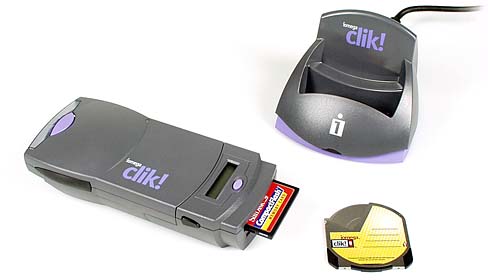
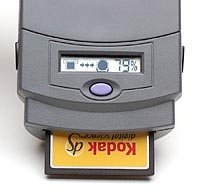
The clik! (lower left), with its charger (top), a 40 MB clik! disk (bottom) and LCD display
showing data transfer information
The LCD display on the clik! shows the transfer taking place and the % complete. The entire front section of the clik! is the card reader section, and this can be removed by pushing the two buttons on each side. When removed, the clik's parallel port is exposed, ready to be connected to a host PC.
The whole package in December 1998 came with a retail price tag of $249, with each 40 MB clik! disk costing $9.99 each when purchased as a pack of 10. This price was comparably a bargain, given that a similar storage capacity in flash memory at the time cost between $120 and $160 each. You could also purchase disks as a 2-pack and a 5-pack.
Just as with earlier Iomega products, everything was well designed and engineered - the clik! disks themselves were a combination of hard plastic and metal, able to keep dust out. Conceptually the same as a 3.5" floppy disk with a hard outer shell housing a spinning flexible magnetic disc, each disk came in a small translucent plastic protective case for added protection.

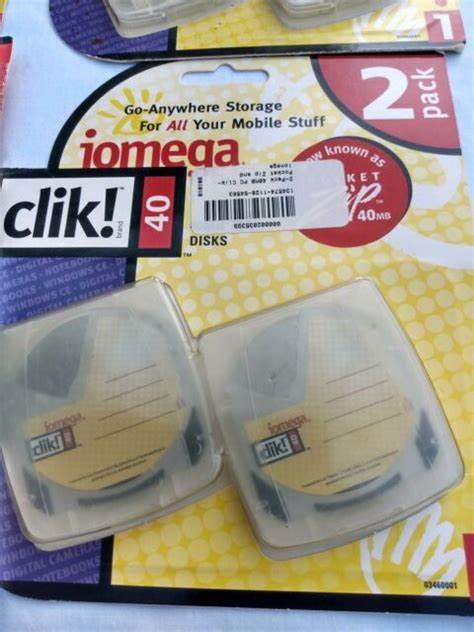
The clik!40 disk, and a 2-pack showing them in their protective cases
Disks were formatted just like a floppy disk and in Windows (95/98) they appeared in Explorer as a 'Removable Disk' just like a floppy.
In January 1999, Iomega released a PCMCIA version of the Clik! for use in laptops. This Type II "PC Card", as PCMCIA was often referred, competed directly with the other popular storage mediums available at the time, including IBM's Microdrive, CompactFlash, and SmartMedia - all of which were solid state (no moving parts) and were hence more reliable but much more expensive.
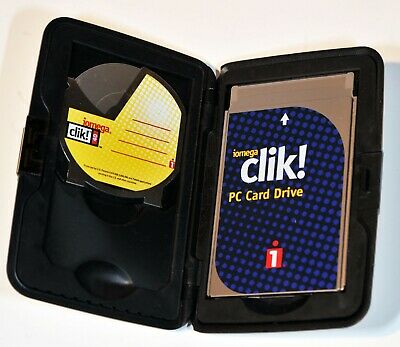
The clik! PCMCIA card in a protective case that also fits 2 disks inside
This PC card version was later renamed PocketZip and came with a USB docking station which was essentially a PCMCIA card reader for connection to a PC, allowing you to access your Clik! disk's contents via USB.
Performance of the Clik! drive was a bit faster than a standard floppy disk, offering a 38ms seek time and sustained data transfer rates of between 150 and 600 KB per second.
The Renaming
By September 2000, sales of the Clik! had been poor, and at this point the infamous 'click of death' that encumbered some Zip drive owners was hitting the headlines. So Iomega attempted to capitalise on its most well-known product, the Zip, and disassociate the Clik! from any comical negative press given its name, by rebranding the Clik! as the PocketZip. By this time, Iomega had also launched their portable music player, the HipZip, which used the Clik! 40 MB disks as its storage medium.
There was also a 100 MB capacity Clik! disk planned but this never materialised.
Goodbye Clik
As much of the media has suspected since its launch, stiff competition in the form of flash-based memory ended up being the downfall of the Iomega Clik!
Storage capacities of CompactFlash (CF) cards was increasing rapidly and costs were coming down. This, coupled with the fact there were no moving parts that could cause them to fail led to CF cards winning over consumers and the digital camera manufacturers. At this time, IBM was introducing their new range of 512 MB and 1 GB Microdrives which also proved popular with professional digital camera users, so it was clear a 40 MB capacity was getting pretty long in the tooth.
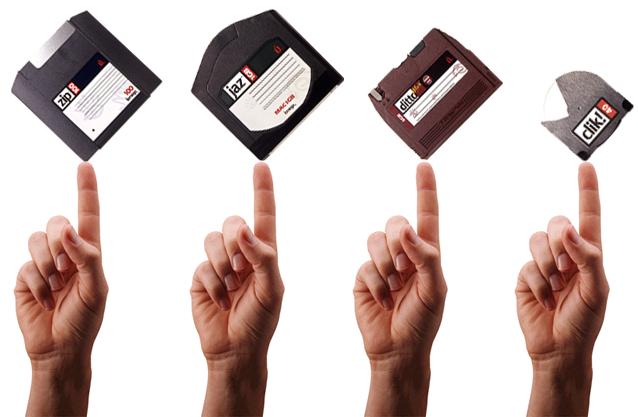
Iomega - a company that made something for everyone!
So What Happened to Iomega?
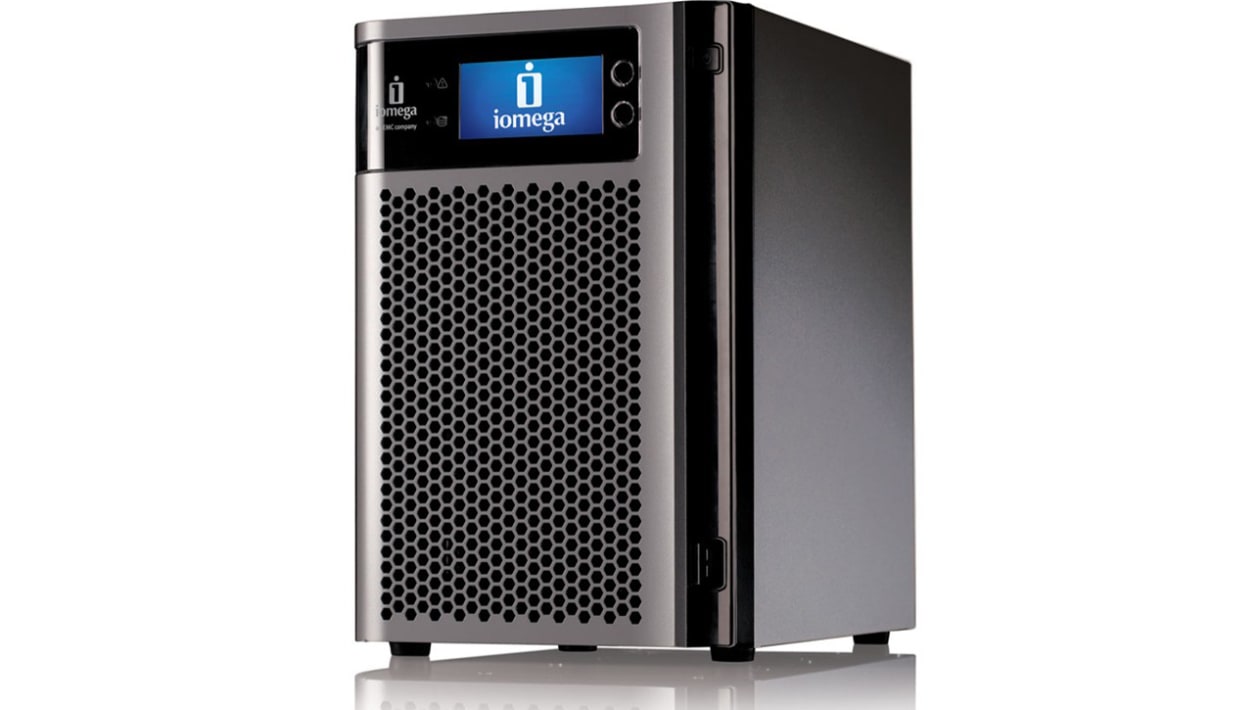 Iomega struggled on with its range of data storage solutions until 2008 after they had branched out into external hard drives and NAS (Network-Attached Storage) solutions, when they were acquired by EMC Corporation for $213M. The Iomega brand was still in use on storage hardware by EMC until at least 2012.
Iomega struggled on with its range of data storage solutions until 2008 after they had branched out into external hard drives and NAS (Network-Attached Storage) solutions, when they were acquired by EMC Corporation for $213M. The Iomega brand was still in use on storage hardware by EMC until at least 2012.
Up to 2013, Iomega had existed as a subsidiary of EMC, but in January of this year, Iomega was renamed LenovoEMC Limited, a joint venture between Lenovo Group and EMC Corporation, with Lenovo owning the majority stake in the new company.
In 2016, Dell Technologies completed the acquisition of EMC Corporation for around $67B, to add what would then be called Dell EMC to the Dell family of companies.